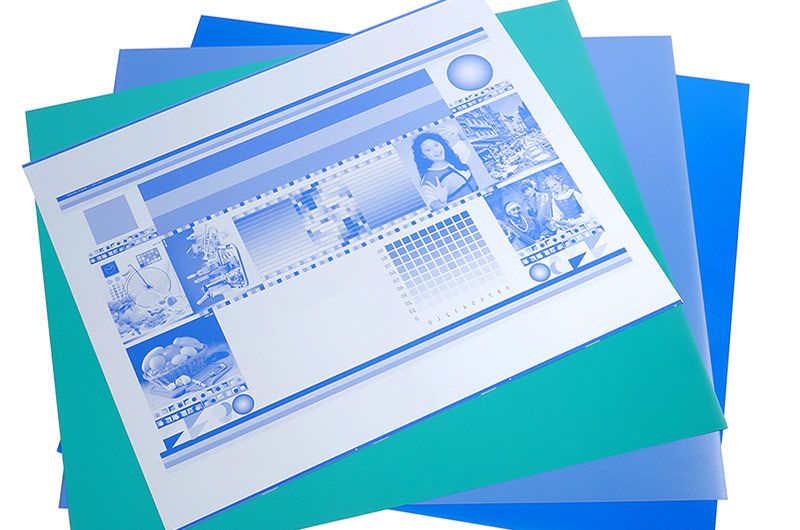
News
Both single layer and double layer CTP plates belong to computer direct platemaking technology, support digital printing process, have high printing accuracy, need to use CTP platemaking machine to expose and develop, suitable for lithography, good environmental protection and better printing durability than traditional PS plates, widely used in books, packaging, commercial printing and other fields.

Single layer and double layer CTP plates have significant differences in structure, performance and application scenarios. The following is a comparative analysis from multiple dimensions:
1. Structural differences
- Single-layer CTP plate
There is only one photosensitive layer, which is directly coated on the aluminum-based plate material and has a simple structure. For example, thermal CTP plate is a single-layer design with the characteristics of bakeable and easy-to-repair plates. The photosensitive layer of the single-layer plate is usually composed of a single resin, an infrared absorber and a photoinitiator. The image is directly formed by laser exposure during the platemaking process.
Contains two functional layers: the upper layer is a protective layer (such as PVA water-soluble polymer) and the lower layer is a photosensitive layer. The upper layer is used for oxygen blocking and protection, and the lower layer is responsible for imaging. Some double-layer plates also add a hydrophilic layer under the photosensitive layer to improve printing suitability.
2. Performance comparison
- Sensitivity and platemaking speed
Single-layer CTP plate: The sensitivity is low, and usually requires high-energy laser exposure. For example, the sensitivity of a thermal single-layer plate is about 10-180 mJ/cm², and the platemaking speed is relatively slow.
Double-layer CTP plate: The sensitivity is higher, especially in the UV-CTP field, the sensitivity of the double-layer plate can reach 0.1-0.54 mJ/cm², the platemaking speed is faster, and it is suitable for efficient production. For example, thermal CTP plate takes "fast sensitivity" as its core advantage to meet the needs of customers with high requirements for publishing efficiency.
- Printing endurance and stability
Single-layer CTP plate: The printing endurance is usually low, and the unbaked single-layer plate can last about 200,000 to 400,000 prints. However, some high-end single-layer plates (such as STP-LI) can achieve higher stability and printability by optimizing the coating process.
Double-layer CTP plate: The printability is significantly higher. For example, the silver salt double-layer plate can reach more than 250,000 prints, and the photopolymer double-layer plate can exceed 1 million prints after baking. The protective layer of the double-layer structure can reduce the erosion of the photosensitive layer by ink and fountain solution during printing, and extend the life of the printing plate.
- Anti-scratch and storage stability
Single-layer CTP plate: sensitive to scratches, and non-imaging areas are prone to image defects due to mechanical friction.
Double-layer CTP plate: The protective layer can effectively buffer external forces and has better scratch resistance. For example, the double-layer CTP plate in a certain invention significantly improves the printability and scratch resistance by adjusting the composition of the hydrophilic layer and the photosensitive layer.
3. Cost and environmental protection
- Cost
Single-layer CTP plate: The production process is simple and the material cost is low. For example, single-layer CTP plate is positioned in the mid-to-low-end market and has a more competitive price.
Double-layer CTP plate: Due to the extra coating process, the cost is usually 10%-30% higher than the single-layer CTP plate. However, in high-end applications, the high printability of the double-layer CTP plate can dilute the cost of a single print.
- Environmental protection
Single-layer CTP plates: Some single-layer CTP plates require chemical development, which may cause waste liquid pollution.
Double-layer CTP plates: Some double-layer CTP plates support treatment-free or on-machine development technology to reduce the use of chemical agents. For example, the double-layer CTP plate in a certain invention achieves direct printing without development by optimizing the coating structure, which is in line with the trend of green printing.
4. Applicable scenarios
- Single-layer CTP plates
Short-run printing: such as commercial quick printing and label printing, the cost is low and the platemaking speed can meet the needs.
High stability requirements: such as book and magazine printing, the single-layer CTP plate has a large development tolerance and is suitable for standardized production.
Budget-limited scenarios: Small and medium-sized printing plants can control initial investment through single-layer CTP plates.
- Double-layer CTP plates
High-end packaging printing: such as cosmetics and electronic product packaging, high resolution and long printing run are required, and the dot reproducibility and printability of the double-layer CTP plate are better.
UV ink printing: The protective layer of the double-layer CTP plate can resist the erosion of UV ink.
Complex graphic printing: such as anti-counterfeiting labels and fine dot printing, the high sensitivity and scratch resistance of the double-layer CTP plate can ensure quality.
5. Technology development trend
Single-layer CTP plates: Developing towards high sensitivity and processing-free. For example, some single-layer CTP plates use nano-coating technology to improve printing durability and simplify the platemaking process.
Double-layer CTP plates: Intelligence and greening have become the focus. The 2025 market report shows that the penetration rate of double-layer CTP plates in the packaging printing field continues to increase, and the new double-layer CTP plate achieves lower COD emissions and higher platemaking efficiency by optimizing coating materials.
Single-layer CTP plates is known for its low cost and high stability, and is suitable for short-run and standardized printing; double-layer CTP plates has an advantage in high-end and long-run printing due to its high sensitivity, printing durability and scratch resistance. When choosing, you need to consider printing needs, budget and environmental protection requirements. With the advancement of technology, the application of double-layer plates in green platemaking and intelligent production will be further expanded, while single-layer plates will consolidate the mid- and low-end markets through technological innovation.
PRODUCTS
ONLINE CONSULTATION
If you have any questions, please contact us and we will contact you as soon as possible.
Leave A Message
If you are interested in our products and want to know more details, please leave a message here, we will reply you as soon as we can.

